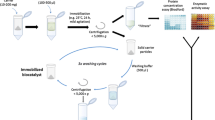Abstract
A novel group of mixed mode adsorbents has been developed for purification of monoclonal and polyclonal antibodies from a broad range of raw materials such as hybridoma cell culture, ascites fluid, animal sera, milk, whey and egg yolk. The aim of this study was to determine whether such mixed mode adsorbents were also useful for the recovery of recombinant proteins from microbial feedstocks. This paper describes the performance of one of these adsorbents for expanded bed capture of a human Fab fragment from recombinant E. Coli cell extracts.
It is concluded that the mixed mode adsorbent binds the Fab fragment efficiently from crude extracts without any requirement for preconditioning the extract by for example de-salting or dilution. The capacity of the mixed mode adsorbent is approx. 12 mg Fab/ml matrix.
The novel mixed mode adsorbent can be useful during production of highly purified Fab fragments as the first step in a purification scheme. In this respect the mixed mode adsorbent is advantageous over alternative commercially available ion-exchange materials which require pre-conditioning of cell extract for Fab' capture. Together with the concentration and clarification effect a significant enrichment of the Fab fragment is obtained in one single high yield operation.
Similar content being viewed by others
References
Carter P, Kelley RF, Rodrigues ML, Snedcor B, Covarrubias M, Velligan MD, Wong WLT, Rowland AM, Kotts CE, Carver ME, Yang M, Bourell, JH, Shepard HM and Henner D, (1992b), High level Esherichia coli expression and production of a bivalent humanized antibody fragment, Bio/Technol 10, 163–167.
Proudfoot KA, Torrance C, Lawson ADG and King DJ, (1992), Purification of recombinant chimeric B72.3 Fab' and F(ab')2 using Streptococcal protein G, Protein Expression & Purification 3: 368–373.
Yon, RJ (1972) Chromatography of lipophilic proteins on adsorbents containing mixed hydrophobic and ionic Groups. Biochem J. 126: 765–767.
Hofstee BHJ (1973) Protein binding by agarose carrying hydrophobic groups in conjunction with charges, Biochem. Biophys. Res. Commun., 50: 751–757.
Yon RJ and Simmonds RJ, (1975) Protein chromatography on adsorbents with hydrophobic and Ionic Groups. Biochem. J., 151: 281–290.
Sasaki I et al (1979) Hydrophobic-ionic chromatography. J. Biochem., 86: 1537–1548.
Bischoff R and McLaughlin L, (1984) Nucleic acid resolution by mixed-mode chromatography, J. Chromatogr., 296: 329–337.
Ruann RC et al. (1988) Dual-functional affinity protein purification. Biotechnol. Prog. 4: 107–112.
Kasche V et al. (1990) Rapid protein purification using phenylbutylamine-eupergit: A novel method for large-scale procedures. J. Chromatogr. 510: 149–154.
Teichberg VI, (1990) Affinity-repulsion chromatography. J Chromatogr. 510: 49–57.
Olander M, Hansen MB and Lihme A (1996) Mixed mode ligands for ionic strength independent high capacity expanded bed adsorption of proteins. Poster at the First International Conference on Expanded Bed Adsorption, Queens' College Cambridge, UK 8–10 December 1996.
Burton SC, Haggarty NW and Harding RK, (1997) One step purification of chymosin by mixed mode chromatography. Biotech and Bioeng., 56(1): 45–55.
Olander M Aa and Lihme A (1998) Mixed mode ligands – sophisticated ‘ion exchangers’ for efficient capture of proteins from crude raw materials. Poster at the Second International Conference on Expanded Bed Adsorption, Napa Valley, CA, USA, 21–23 June 1998. Paper submitted for publication in Bioseparation.
Hansen MB and Lihme A (1996) A new protein A mimicking affinity matrix for expanded bed purification of monoclonal antibodies. Poster at the First International Conference on Expanded Bed Adsorption, Queens' College Cambridge, UK 8–10 December 1996.
Patent application: A. Lihme and M.B. Hansen, “Isolation of Immunoglobulins”, PCT/DK97/00359
Lihme A, Nielsen CS and Bøg-Hansen TC (1990) Substance carrying conglomerate. Patents: EP 0538.350, EP 0607998.
Lihme A and MB Hansen (1997) American Biotechnology Laboratory, July, “Protein A mimetic for large-scale monoclonal antibody purification”.
Humphreys DP, Vetterlain OH, Chapman AP, King DJ, Antoniw P, Suitters AS, Reeks DG, Parton TAH, King LM, Smith BJ, Lang V and Stephens PE, (1998), Fab'2 molecules made from Escherichia coli produced Fab' with hinge sequences confering increased serum survival in an animal model. J. Immunol. Methods 217: 1–10.
FastMabs A™, User Guide. UpFront Chromatography A/S, p. 3.
Lihme A, Nielsen CS and Bøg-Hansen TC (1990) Method of distributing a liquid in a fluid bed reactor. Patent application: EP 0722771 A1.
Lihme A, Zafirakos E, Hansen MB and Olander M (1998) Simplified and more robust EBA processes by elution in expanded bed mode. Poster at the Second International Conference on Expanded Bed Adsorption, Napa Valley, CA, USA, 21-23 June 1998. Paper accepted for publication in Bioseparation
Author information
Authors and Affiliations
Rights and permissions
About this article
Cite this article
Hansen, M.B., Lihme, A., Spitali, M. et al. Capture of human Fab fragments by expanded bed adsorption with a mixed mode adsorbent. Bioseparation 8, 189–193 (1999). https://doi.org/10.1023/A:1008180501180
Issue Date:
DOI: https://doi.org/10.1023/A:1008180501180




